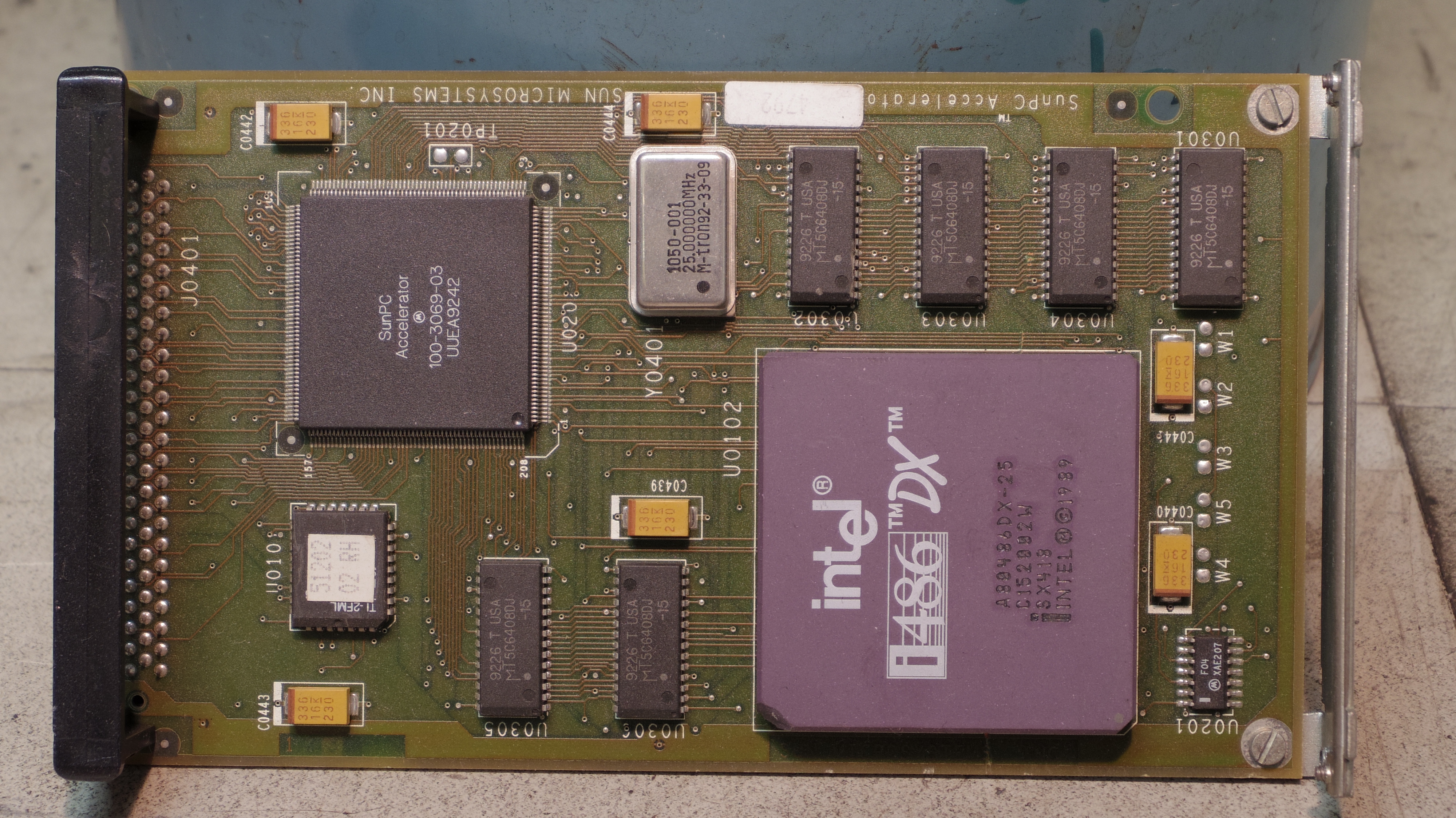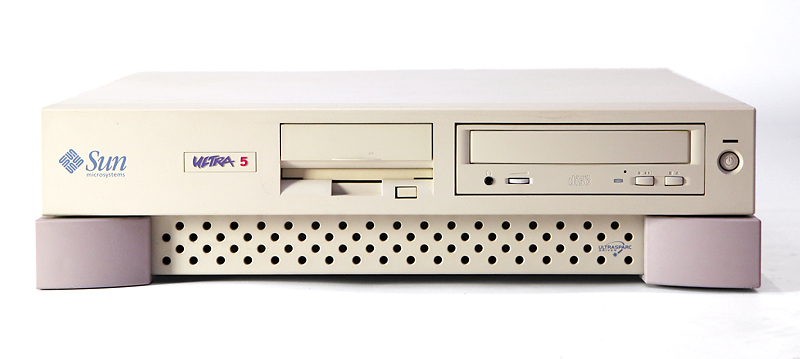Sun PCi on:
[Wikipedia]
[Google]
[Amazon]
 SunPCi is a series of
SunPCi is a series of
 These cards were the successor to the earlier SunPC cards that had been available for Sun SBus or VME systems. Prior to this a software only
These cards were the successor to the earlier SunPC cards that had been available for Sun SBus or VME systems. Prior to this a software only  The Ultra 5 workstation with an optional SunPCi for running Windows 95 or NT was announced in November 1998. The next year Ultra 5 systems including a SunPCi with a 300 MHz AMD K6-2 processor and 64 to 256 MB RAM were available. Windows applications running on this system were measured to be 40% slower than a desktop PC with a 300 MHz Pentium II, but the card was cheaper than purchasing a new PC. Following an in-depth review in 1999 with an original 300MHz 64mb memory SunPCi card, Kevin Railsback in
The Ultra 5 workstation with an optional SunPCi for running Windows 95 or NT was announced in November 1998. The next year Ultra 5 systems including a SunPCi with a 300 MHz AMD K6-2 processor and 64 to 256 MB RAM were available. Windows applications running on this system were measured to be 40% slower than a desktop PC with a 300 MHz Pentium II, but the card was cheaper than purchasing a new PC. Following an in-depth review in 1999 with an original 300MHz 64mb memory SunPCi card, Kevin Railsback in
 SunPCi is a series of
SunPCi is a series of single-board computer
A single-board computer (SBC) is a complete computer built on a single circuit board, with microprocessor(s), memory, input/output (I/O) and other features required of a functional computer. Single-board computers are commonly made as demonst ...
s with a connector that effectively allows a PC motherboard to be fitted in Sun Microsystems
Sun Microsystems, Inc., often known as Sun for short, was an American technology company that existed from 1982 to 2010 which developed and sold computers, computer components, software, and information technology services. Sun contributed sig ...
SPARC-based workstation
A workstation is a special computer designed for technical or computational science, scientific applications. Intended primarily to be used by a single user, they are commonly connected to a local area network and run multi-user operating syste ...
s based on the PCI
PCI may refer to:
Business and economics
* Payment card industry, businesses associated with debit, credit, and other payment cards
** Payment Card Industry Data Security Standard, a set of security requirements for credit card processors
* Prov ...
architecture adding the capability for the workstation to act as a 'IBM PC compatible
An IBM PC compatible is any personal computer that is hardware- and software-compatible with the IBM Personal Computer (IBM PC) and its subsequent models. Like the original IBM PC, an IBM PC–compatible computer uses an x86-based central p ...
' computer. The Sun PCi cards included an x86
x86 (also known as 80x86 or the 8086 family) is a family of complex instruction set computer (CISC) instruction set architectures initially developed by Intel, based on the 8086 microprocessor and its 8-bit-external-bus variant, the 8088. Th ...
processor, RAM, expansion ports, and an onboard graphics controller, allowing a complete Wintel
Wintel (portmanteau of ''Windows'' and ''Intel'') is the partnership of Microsoft and Intel producing personal computers (PCs) using Intel x86-compatible processors running Windows.
Background
By the early 1980s, the chaos and incompatibility ...
operating environment
In computer software, an operating environment or integrated applications environment is the environment in which users run application software. The environment consists of a user interface provided by an applications manager and usually an ap ...
on a Solaris
Solaris is the Latin word for sun.
It may refer to:
Arts and entertainment Literature, television and film
* ''Solaris'' (novel), a 1961 science fiction novel by Stanisław Lem
** ''Solaris'' (1968 film), directed by Boris Nirenburg
** ''Sol ...
system. The SunPCi software running on Solaris emulates the disk drives that contain the PC filesystem. The PC software running on the embedded hardware is displayed in an X window
The X Window System (X11, or simply X) is a windowing system for bitmap displays, common on Unix-like operating systems.
X originated as part of Project Athena at Massachusetts Institute of Technology (MIT) in 1984. The X protocol has been a ...
on the host desktop; there is also a connector on the edge of the board that can optionally be used to connect a PC monitor.
History
The product arose from the issue of people who were working on a Unix workstation that was typically not Intel-based being sent a file from aMicrosoft Windows
Windows is a Product lining, product line of Proprietary software, proprietary graphical user interface, graphical operating systems developed and marketed by Microsoft. It is grouped into families and subfamilies that cater to particular sec ...
based PC and being unable to handle the file. Sun termed this problem ''interoperability''. By the year 2000 solutions to the problem such as emulator
In computing, an emulator is Computer hardware, hardware or software that enables one computer system (called the ''host'') to behave like another computer system (called the ''guest''). An emulator typically enables the host system to run sof ...
s were available but their performance at the time was quite problematic. With Sun workstations adopting the PCI hardware bus standard this became possible.
 These cards were the successor to the earlier SunPC cards that had been available for Sun SBus or VME systems. Prior to this a software only
These cards were the successor to the earlier SunPC cards that had been available for Sun SBus or VME systems. Prior to this a software only application binary interface
An application binary interface (ABI) is an interface exposed by software that is defined for in-process machine code access. Often, the exposing software is a library, and the consumer is a program.
An ABI is at a relatively low-level of a ...
and DOS emulator called Wabi was used. SunPC was offered as a replacement software emulator that could be used to run more advanced applications, with higher performance, by adding an X86 hardware accelerator. In 1992 the SunPC Accelerator SX (16 MHz 486SX) or SunPC Accelerator DX (25 MHz 486DX) were available for SBus workstations, though the SunPC program emulates the PC memory with or without the accelerator present. An accelerator card is needed for software that requires 80386 or 80486 hardware, such as Windows 3.11 running in enhanced mode or Windows 95; without this hardware SunPC runs in software-only mode which emulates an 80286. In 1997 a 133 MHz 5x86 AMD SBus co-processor was available.
 The Ultra 5 workstation with an optional SunPCi for running Windows 95 or NT was announced in November 1998. The next year Ultra 5 systems including a SunPCi with a 300 MHz AMD K6-2 processor and 64 to 256 MB RAM were available. Windows applications running on this system were measured to be 40% slower than a desktop PC with a 300 MHz Pentium II, but the card was cheaper than purchasing a new PC. Following an in-depth review in 1999 with an original 300MHz 64mb memory SunPCi card, Kevin Railsback in
The Ultra 5 workstation with an optional SunPCi for running Windows 95 or NT was announced in November 1998. The next year Ultra 5 systems including a SunPCi with a 300 MHz AMD K6-2 processor and 64 to 256 MB RAM were available. Windows applications running on this system were measured to be 40% slower than a desktop PC with a 300 MHz Pentium II, but the card was cheaper than purchasing a new PC. Following an in-depth review in 1999 with an original 300MHz 64mb memory SunPCi card, Kevin Railsback in InfoWorld
''InfoWorld'' (''IW'') is an American information technology media business. Founded in 1978, it began as a monthly magazine. In 2007, it transitioned to a Web-only publication. Its parent company is International Data Group, and its sister pu ...
magazine noted the price was competitive and the performance was suitable for business applications especially when using the output attached to the SunPCi to a dedicated monitor. The downsides were that a separate license was required for the Windows 95 operating system, MS-DOS disk drivers performed slowly and DirectX was not available unless using the separate dedicated monitor. The 600 MHz SunPCi II was introduced in 2000. With the release of version 2.2 of the SunPCi II software in 2001 it was possible to have more than one accelerator card in a workstation or entry-level Sun Enterprise server. By 2005 the SunPCi IIIpro was available for workstations such as the Sun Blade 150.
Hardware and software
Hardware
According to Sun documentation the "... coprocessor card is not just PC-compatible, it is an actual PC that is constructed from real PC components and follows the ''de facto'' and emerging PC hardware design standards."Software
The SunPCi I coprocessor with version 1.3 software, the final release for SunPCi I hardware, is compatible with Solaris 2.5.1, 2.6, 7 or 8 running on the host. Solaris 9 support was included starting with the SunPCi II hardware and version 2.3.1 software. The SunPCi III is supported on Solaris 10 with patches, but SunPCi II is not. The first version of the SunPCi card was intended to run Windows 95 or NT. The cards were not limited to just "officially" supported operating systems; according to Sun "Because the card is a PC system, future Microsoft Windows operating systems should also be compatible." Later, the following Windows and Linux operating systems were officially supported by Sun on the SunPCi IIIpro: * Microsoft Windows 2000 Professional * Microsoft Windows 2000 Server * Microsoft Windows XP * Microsoft Windows Server 2003 * Red Hat 9 Personal/Professional * Red Hat Enterprise Linux 3 WS/ES Some people have also claimed to successfully run some other operating systems on particular SunPCi cards, includingNetBSD
NetBSD is a free and open-source Unix-like operating system based on the Berkeley Software Distribution (BSD). It was the first open-source BSD descendant officially released after 386BSD was fork (software development), forked. It continues to ...
and Debian Linux
See also
* Sun386i, Sun Microsystems Intel based workstation productNotes
References
{{reflist, refs= {{cite journal, last=Tougaw, first=Douglas , date=15 August 2000 , title=Sun PCi Provides the Best of Two Worlds , journal=Computing in Science & Engineering , volume=42 , issue=4 , publisher=IEEE/AIP , pages=4–8 , doi=10.1109/MCISE.2000.852386, bibcode=2000CSE.....2d...4T Compatibility cards IBM PC compatibles Single-board computers Sun Microsystems hardware